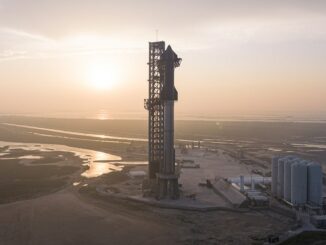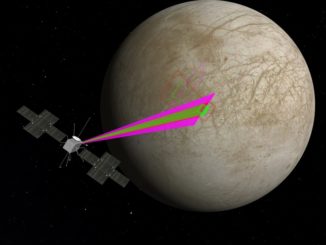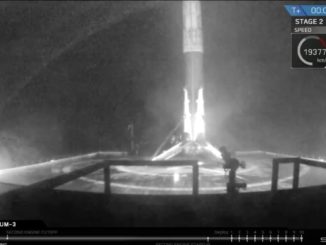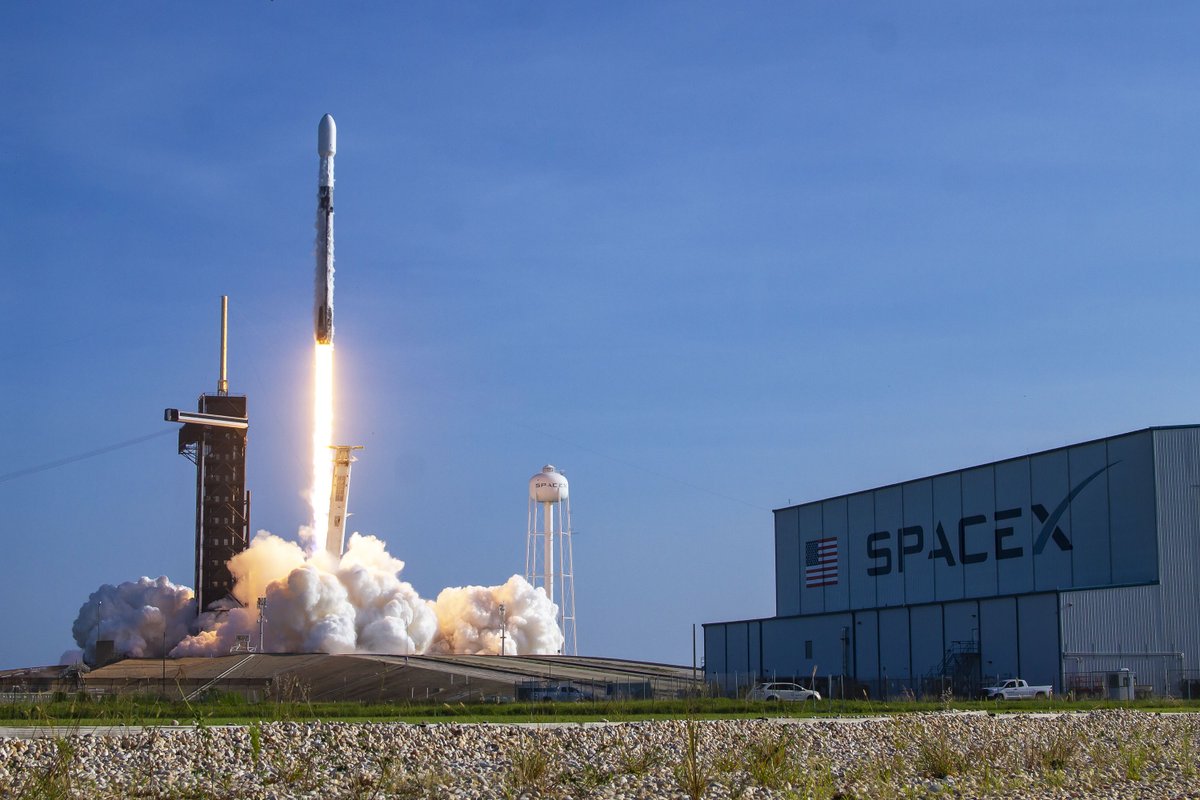
Sixty more satellites launched Thursday from the Kennedy Space Center to join SpaceX’s Starlink fleet, adding coverage to the broadband network as it is already “well into the first phase of testing.”
The next 60 Starlink relay nodes blasted off at 8:46:14 a.m. EDT (1246:14 GMT) Thursday on top of a Falcon 9 rocket, riding SpaceX’s workhorse launcher into an orbit more between about 130 miles and 210 miles (210 and 340 kilometers) above Earth.
Nine main engines powered the Falcon 9 off pad 39A at the Florida spaceport, then vectored their thrust to steer the rocket toward the northeast to line up with an orbital plane in the Starlink satellite fleet.
After finishing its job on Thursday’s launch, the Falcon 9’s reusable first stage booster landed on SpaceX’s drone ship “Of Course I Still Love You” holding position in the Atlantic Ocean a couple hundred miles east of Charleston, South Carolina.
The propulsive pinpoint landing marked the 60th time SpaceX has recovered a Falcon 9 booster, and it completed the second trip to space and back for the specific rocket flown Thursday.
Meanwhile, the Falcon 9’s upper stage engine injected the 60 Starlink satellites into an on-target orbit tilted 53 degrees to the equator. Retention rods released to allow the flat-panel satellites to fly free of the Falcon 9 rocket around 15 minutes after liftoff.
SpaceX declared success on the mission, which was the company’s second launch in less than four days from separate pads on Florida’s Space Coast.
It was the 101st launch in SpaceX’s history, and the 93rd flight of SpaceX’s workhorse Falcon 9 launcher. It was also the 16th launch by SpaceX so far this year.
After their deployment from the Falcon 9 rocket, the Starlink satellites were expected to extend solar panels and activate krypton ion thrusters to begin raising their orbit to the Starlink network’s operational shell roughly 341 miles (550 kilometers) above Earth.
With the 60 fresh satellites launched Thursday, SpaceX has delivered 713 Starlink satellites to orbit on 12 Falcon 9 rocket missions since May 2019. Some of the satellites, including those on the first Starlink launch last May, are being moved to lower altitudes and deorbited.
SpaceX eventually plans to launch thousands of Starlink satellites, but the first tranche of Starlinks will number 1,440 spacecraft, according to Jonathan Hofeller, SpaceX’s vice president of Starlink and commercial sales.
“The total global constellation we’re targeting is 1,440 satellites, of which a good number of those are already on orbit,” Hofeller said.
Each flat-panel Starlink satellite weighs about a quarter-ton, and they are built at a SpaceX facility in Redmond, Washington, near Seattle. Extending on SpaceX’s penchant for building hardware in-house, the aerospace company is manufacturing its own Starlink satellites, user terminals and ground stations.
SpaceX’s Starlink megaconstellation is already the largest fleet of satellites in the world, but hundreds more will be launched in the coming months.
Hofeller said last month that SpaceX is building six Starlink spacecraft per day, and plans to launch Starlink missions at intervals of every two to three weeks until completing the initial Starlink network of around 1,440 satellites.
SpaceX has regulatory approval from the Federal Communications Commission to eventually operate nearly 12,000 Starlink satellites to blanket the planet with high-speed, low-latency Internet signals.
Kate Tice, a SpaceX engineer who anchored the company’s launch webcast Thursday, said the Starlink team is “still in the beginning stages of our global space-based Internet constellation.”
“But we are well into our first phase of testing with our private beta program with plans to roll out a public beta later this year,” Tice said.
In a discussion at the ASCEND Space Science and Technology Summit last month, Hofeller said that the private beta testing is being rolled out in the Pacific Northwest. With roughly 700 satellites, the Starlink network has enough coverage to provide connectivity to users at high latitudes, but more launches are required to expand coverage to other regions.
SpaceX has asked people interested in participating in the public beta test phase to sign up on the Starlink website.
“As employees have been using Starlink, the Starlink team has been collecting latency statistics, and performing standard speed tests of the system,” Tice said. “This means that we’re checking how fast data travels from the satellite to our customers and then back to the rest of the Internet. Initial results have been good.”
SpaceX said Thursday that the tests so far show the network has “super low latency” with download speeds greater than 100 megabits per second. That’s fast enough to stream multiple HD movies at once, and still have bandwidth to spare, according to SpaceX.
Tice said the Starlink network is “still very much a work in progress,” and SpaceX plans to introduce new capabilities to improve coverage and service.
She said SpaceX recently completed a test of satellites in orbit equipped with inter-satellite laser links.
“With these space lasers, the Starlink satellites are able to transfer hundreds of gigabytes of data,” Tice said. “Once these space lasers are fully deployed, Starlink will be one of the fastest options available to transfer data around the world.”
Hofeller hinted at upgraded Starlink satellites in his virtual presentation at an aerospace industry conference last month.
“With 1,440 satellites, that’s when we get 24/7 global coverage, and the plan is to not stop there,” Hofeller said. “We’ll continue to launch, and with each launch, we can provide more and more capacity. There’s never enough capacity. You can’t limit what your kids want to watch, and what your family wants to consume. So we’ll continue to densify the network.”
SpaceX will deorbit older Starlink satellites as upgraded spacecraft come online, according to Hofeller.
The Falcon 9 rocket has released another 60 Starlink satellites into orbit.
With this launch, SpaceX has delivered 713 Starlink spacecraft to orbit in the last 16 months.https://t.co/OIZVYLQdef pic.twitter.com/R7U02eYRYB
— Spaceflight Now (@SpaceflightNow) September 3, 2020
He declined to comment on when SpaceX might begin launching a new generation of Starlink satellites, or how many satellites SpaceX might eventually put into space. SpaceX calls the current satellites Version 1.0.
The company submitted filings with the International Telecommunication Union seeking authorization for up to 42,000 broadband satellites, beyond the 12,000 previously approved by the FCC.
SpaceX is not the only company aiming to build out a broadband network consisting of hundreds or thousands of satellites.
Amazon plans a fleet of thousands of satellites for its Kuiper Internet project, and the British government announced in July it will take a stake in OneWeb, a would-be broadband provider that filed for bankruptcy in March after launching 74 satellites in a planned constellation of 648 spacecraft.
“Our competition is fierce,” Hofeller said. “We know that the United Kingdom, Canada and China have also invested in low Earth orbit satellite constellations and emerging technologies. The U.S. has done a lot to kind of support this low earth orbit network and support this industry, which I think has clearly put us as a frontrunner, but we have a bunch of big decisions in front of us from an FCC standpoint.”
SpaceX is seeking to obtain a slice of billions of dollars in federal subsidies to expand broadband coverage to the rural United States. Those subsidies have historically gone to operators of terrestrial telecom networks.
“As the U.S. government evaluates technologies, we are a strong strong believer that the best technologies should win, independent of the technologies,” Hofeller said. “So a tech neutral approach when we look at government subsidies.”
Hofeller also mentioned concerns raised about the Starlink network by orbital debris experts and astronomers. He said SpaceX lowered the Starlink satellite altitude to 341 miles to help ensure dead spacecraft quickly fall out of orbit.
“You don’t want to be up there for tens to hundreds of years,” he said. “You want it to be up there on the order of months, and lowering the altitude does that.”
Astronomers expressed worries about the Starlink fleet’s impact on ground-based observatories after the the first 60 satellites were significantly brighter than expected. The satellites’ reflective surfaces — such as solar arrays and antennas — bounced sunlight to the ground as they flew overhead at dawn and dusk.
SpaceX introduced a darker coating on Starlink satellites earlier this year, and debuted a modified satellite design in June that incorporated a radio-transparent sunshade to make the spacecraft less reflective. Those efforts had some success, astronomers said last month they expect future Starlink satellites will be dim enough to avoid impacts on amateur astronomy and dark sky enthusiasts.
But professional astronomers working at the largest ground-based telescopes will still have to account for the Starlink satellites in their observations.
Astronomers on Aug. 25 announced findings from a four-day virtual workshop arranged by the National Science Foundation and the American Astronomical Society to assess the impacts of tens of thousands of small low Earth orbit satellites on ground-based astronomy.
“As a result of this extensive study, we found that all optical astronomical observatories will be affected to some degree by light pollution caused by orbiting low Earth orbit satellites,” said Tony Tyson, a professor of physics at the University of California, Davis, and chief scientist for the Vera Rubin Observatory under construction in Chile.
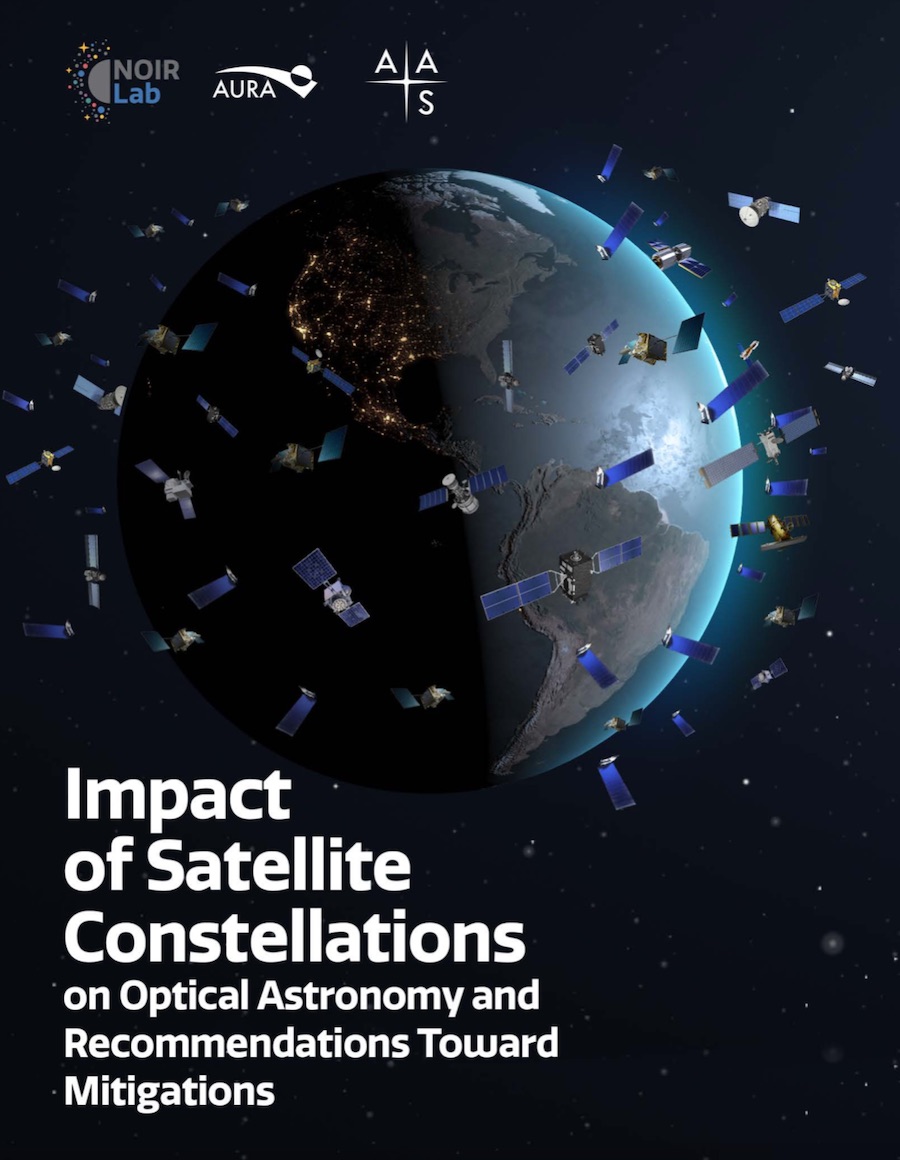
But software could be developed to mask streaks and trails in wide-field images, allowing scientists to still obtain usable data, albeit with an extra processing step. Sophisticated algorithms could also help astronomers know when and where to point to avoid imaging a satellite.
Astronomers said launching satellites below 373 miles, or 600 kilometers, would reduce the number of spacecraft visible in the sky at one time. SpaceX’s Starlink satellites fly lower than that threshold, but OneWeb’s fleet orbit at 745 miles, or 1,200 kilometers.
Participants in the workshop said SpaceX has been proactive in responding to the concerns of astronomers. Tyson said Amazon and OneWeb are also in early-stage discussions with the astronomy community.
“I think we’ve explored all of the parameter space allowed by physics,” Tyson said, “other than being clever and launching fewer satellites, or doing something else.”
“We’re actively trying to make this right,” Hofeller said last month. “As space lovers and space geeks, we don’t want to affect the ability to study the stars. So I think our interests are aligned to try to find a common solution.”
Email the author.
Follow Stephen Clark on Twitter: @StephenClark1.

